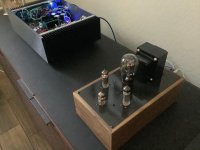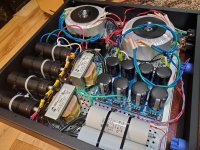Cool.
1) Do another FFT.
Want to see how much progress you have made improving it.
2) Once you have it all biased, give it an hour to hit thermal equilibrium and give it a listen.
3) After that, retighten mosfet mounting bolts one more time, then do one more rebias/dc offset adjustment.
Did you order the Antek Can/Cover ?
Hi Pico,
I measured yesterday and basically, the performance was about the same as before. I rebiased, let it sit, did the MOSFET tightening. Listened to it again last night. It is starting to sound quite fabulous now.
Looking into the Antek cover.
Got my amp running. Had to play with the R9 to bias it properly and ended up using ~8k resistor instead of 10k. Those R6/R7 measure ~13.5V Have Jfets with 8.9mA from back in the days when you could just buy them from Spencer (man like almost 10 years ago...).
There is one problem I am struggling -- DC offset. Looks like my outputs are not that great, but not that bad either Bias is from 220mV to 235mV if I measure all of them. Can not bring DC lower than 100mV. Any suggestions (apart going with tighter outputs for now)?
There is one problem I am struggling -- DC offset. Looks like my outputs are not that great, but not that bad either Bias is from 220mV to 235mV if I measure all of them. Can not bring DC lower than 100mV. Any suggestions (apart going with tighter outputs for now)?
It is starting to sound quite fabulous now.
Excellent!
Ordered the Antek cover. I already have some blank AL to make a mounting plate and some L-channels to mount it.
Incidentally, I just measured the M2 and it has the same noise as I measured in the F4. That was a relief. That means it is my measuring setup or environment that is injecting the noise. It's all in the open and there was at least one wall wart around, so, that could be it. Both the M2 and the F4 are dead quiet of course on the 110 db/W horns.
Been enjoying the F4 and starting to see it's character. It is quite lovely.
Incidentally, I just measured the M2 and it has the same noise as I measured in the F4. That was a relief. That means it is my measuring setup or environment that is injecting the noise. It's all in the open and there was at least one wall wart around, so, that could be it. Both the M2 and the F4 are dead quiet of course on the 110 db/W horns.
Been enjoying the F4 and starting to see it's character. It is quite lovely.
Just tried this for the first time and it is absolutely amazing sounding: no sonic cues were harmed in this experiment  The SEP OTs (4 ohm secondaries) were shunted with 4R7 3W so that the right load-line would be seen by the tube amp. The F4, by way of adding DF and current, adds AUTHORITY!
The SEP OTs (4 ohm secondaries) were shunted with 4R7 3W so that the right load-line would be seen by the tube amp. The F4, by way of adding DF and current, adds AUTHORITY!
The SE tube amp is very simple, and very quite, and so is the F4. So I run all of this without a line stage with either 2V or 3.5V from one of my two tube dacs.

The SE tube amp is very simple, and very quite, and so is the F4. So I run all of this without a line stage with either 2V or 3.5V from one of my two tube dacs.

The SE tube amp is very simple, and very quite, and so is the F4. So I run all of this without a line stage with either 2V or 3.5V from one of my two tube dacs. [/ATTACH]
Decware clone?
Uh-oh. I was moving my main stereo to another room when I fumbled my F4 and semi-dropped it, managing to recover so it didn't hit the floor, though it landed in a chair. When I listened later, one channel was about 1/3 the loudness of the other. Switching loudspeaker connections confirmed that one channel was weak (but I'm not 100% sure it's not the preamp yet; to be confirmed later). Aside from looking for anything broken and maybe checking the bias, is there any other troubleshooting tricks I can try?
Uh-oh. I was moving my main stereo to another room when I fumbled my F4 and semi-dropped it, managing to recover so it didn't hit the floor, though it landed in a chair. When I listened later, one channel was about 1/3 the loudness of the other. Switching loudspeaker connections confirmed that one channel was weak (but I'm not 100% sure it's not the preamp yet; to be confirmed later). Aside from looking for anything broken and maybe checking the bias, is there any other troubleshooting tricks I can try?
Maybe just a cracked solder joint. Check the bias on that channel. Hit all of the joints with your iron.
Hi folks. So I was reading about some $20k+ amps and read that each rail had it's own power supply transformer. This cued me to realize that I had a totally unused transformer in my power supply and could easily try this out for my f4 monoblocks (image below). Both transformers are identical, 400v anteks with dual 18v secondaries.
My question is, if I do this, what should I do with the extra secondaries. I read recommendations to just heat shrink each wire and then tie up the pair. Other people recommended connecting them in parallel to a single rectifier.
Any opinions from this group?
Thanks as always.
My question is, if I do this, what should I do with the extra secondaries. I read recommendations to just heat shrink each wire and then tie up the pair. Other people recommended connecting them in parallel to a single rectifier.
Any opinions from this group?
Thanks as always.
Attachments
Great, thanks.
I read that there could be some problems if the windings weren't matched even if nominally rated as identical. Was thinking that really wouldn't be a problem here, but thought I'd go ahead and check. In many cases, I think the concern came from using identically rated secondaries across different transformers, thereby increasing the chances of voltage differences.
I read that there could be some problems if the windings weren't matched even if nominally rated as identical. Was thinking that really wouldn't be a problem here, but thought I'd go ahead and check. In many cases, I think the concern came from using identically rated secondaries across different transformers, thereby increasing the chances of voltage differences.
- Home
- Amplifiers
- Pass Labs
- F4 power amplifier


